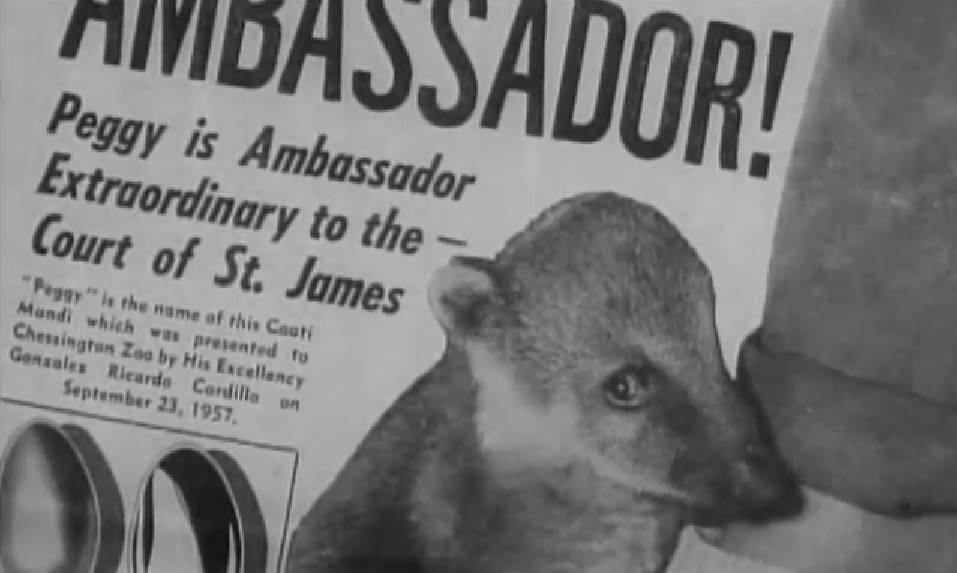You Killed
Elizabeth
Three Cases of Murder
The curious case
of a certain Edgar, who mixes his drinks and blacks out from time to time, following
Toye on Turner (here, Alan Badel plays the observant barman).
Zoo Baby

Case of the young
lad not quite “sivilized”, Dad has the Hatari! job in Nairobi, putting a giraffe in
the Paris Zoo.
The wilds of
Wimbledon Common and Richmond Park, to say nothing of Hampton Court. “Ugh,
film units! We had a film unit here last week, frightened the bear cubs half to
death.”
“Tsk, filming ain’t no good
for animals. There was once a good half-dozen vultures
‘ere. They borrowed ‘em for a film.”
“What
happened to them?”
“Starved ‘em,
I tell you. Starved ‘em t’ the bone! Riders o’ Death Valley, they
called it.” Vd.
on this most obscure point Asquith’s The
V.I.P.s a few years later, cf.
Pasolini’s contribution to Rogopag (Laviamoci il cervello), “La ricotta”.
The divine creature, gift of a generalissimo, is a female cousin to Popeye’s
Jeep, her incidental and fortuitous liberation nevertheless anticipates Turtle Diary (dir. John Irvin), though
here it has the makings of an international incident on top of everything else,
“didn’t you know I was a dangerous
Red?”
An assured work
of genius by the assiduous screenwriter Jan Read, designed by Duncan
Sutherland, the swan song of Ernest Palmer, scored by Edwin Astley.
Faces in the Dark
A masterpiece on
the business motif also to be found in Lubin’s Impact and by reflection Maté’s D.O.A.
Unquestionably
the subject is a light bulb, in cartoon parlance an idea, the Apollo light
bulb. Others want a share in the production, the partner has doubts in the
company, a tremendous expense is involved.
The man with the
idea has enemies on every side and doesn’t know it, he sees incidental
opposition easily brushed aside, that’s all.
He is blinded in
a testing accident (Welles’ Citizen
Kane for this, the breakdown), and as a blind man learns to
“see” in other senses, the nightmare begins to take shape, have
definition, marvelously detailed and exact, excruciating, maddening, nothing
like it until Tony Richardson’s Laughter
in the Dark except Lubin and Maté.
John Gregson
lurching awkwardly like Frankenstein’s monster or Orson Welles per
Truffaut’s description, Mai Zetterling the German wife, John Ireland the
playboy brother, Michael Denison the partner, et al.
Desmond Davis
works the camera for Ken Hodges, Mikis Theodorakis wrote the score, from the
authors of Les Diaboliques (dir. Henri-Georges Clouzot), Vertigo (dir. Alfred Hitchcock), Les Yeux sans Visage and
Pleins feux sur l’assassin (dir.
Georges Franju), etc.
Nonsense in Halliwell’s Film Guide,
“puzzler”, Hitchcock manqué,
etc.
The Hi-Jackers
The Saint
The inside job on
U.S. Army PXs in Germany is an essential factor of Ford’s Gideon’s
Day, this is a very keen analysis taken up by Pinter in Michael
Anderson’s The Quiller Memorandum, which supplies all the
understanding needed except for the curious point of blonde and beautiful
Mathilde’s character, “running”, and that is reflected back
into Anderson’s film very usefully.
Munich,
Oktoberfest (note the Fernsprecher in the parade sequence).